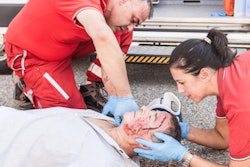
If a CT scan of a patient with obtunded blunt trauma is normal, is a follow-up MRI scan still needed to ensure the person doesn't have cervical spine trauma? Probably not, according to new research published in JAMA Surgery.
In the analysis, co-first author Dr. Ajay Malhotra and colleagues from Yale University assessed the cost-effectiveness and clinical benefit of performing MRI of the cervical spinal cord following a normal CT result for patients who presented with obtunded blunt trauma. They found that examining the spine on CT scans resulted in a lower total cost and a higher quality-adjusted life year (QALY) measure for these patients, compared with using CT plus follow-up MRI (JAMA Surg, March 14, 2018).
The findings of this economic decision analysis do not support the use of MRI for obtunded blunt trauma patients cleared for cervical spine injuries on initial CT, the authors wrote. There is a need for more research on this topic before clinicians can consider MRI beneficial in this setting.
"Increased awareness and discussion of the risks versus benefits of MRI in blunt trauma will lead to a more objective evaluation of its utility," they wrote.
Clinical imaging dilemma
There has been controversy over the ideal imaging protocol for ruling out injury to the cervical spinal cord after blunt trauma in patients who are obtunded, defined as being dazed or lacking full consciousness. The risk is that if such an injury remains undetected, it could result in paralysis.
Current research suggests that a normal CT finding is enough to clear this injury, yet clinicians frequently order follow-up MRI exams. Indeed, many guidelines still recommend performing follow-up MRI within 48 to 72 hours of blunt trauma even when there is no indication of injury on initial CT scans; this is despite research demonstrating that follow-up MRI offers low utility, higher costs, longer scanning times, and increased risk of complication during transport, they noted.
The rationale for this clinical practice stems in large part from the seriousness of the potential consequence -- i.e., quadriplegia -- associated with missing early signs of internal damage around the head and neck.
Seeking to shed light on this issue, Malhotra and colleagues conducted a cost-effectiveness analysis of follow-up MRI after normal CT for patients who sustained blunt cervical trauma using a decision-making model they programmed with computer software (TreeAge Pro 2017, TreeAge Software).
"[Our] Markov model design represents the clinical pathways in patients with blunt cervical trauma with the anticipated implications of the imaging results on downstream processes of directing clinical care and using healthcare resources, patient outcomes, and healthcare costs," they wrote.
The model listed quadriplegia as the ultimate outcome of a missed spinal cord injury, because any less-severe outcome would only favor not performing follow-up MRI. Also, the analysis did not factor in the cost of surgery after a false-positive MRI finding, which would have further increased the cost and reduced the effectiveness of follow-up MRI.
Several key variables included in the analysis were the negative predictive value for detecting cervical spine injuries on initial CT (99.88%), the sensitivity of MRI (79.6%), the specificity of MRI (25%-40%), the cost of MRI after Medicare reimbursement ($371.85), the percentage of missed spinal cord injuries on CT leading to neurologic damage (29%), and the risk of spinal cord injuries developing into tetraplegia (55%).
No follow-up MRI?
Using their model, the researchers calculated the net monetary and utility benefit of performing follow-up MRI after a normal CT finding in a model of 10,000 simulations resembling different patient cases.
They discovered that no follow-up imaging was more beneficial than follow-up MRI in all 10,000 iterations. For the base case scenario of a 40-year-old patient with obtunded blunt trauma, follow-up MRI increased total costs by $13,126 and offered 0.09 fewer quality-adjusted life years than CT alone.
| CT alone vs. CT and follow-up MRI to assess cervical spine trauma | ||||
| Patient age | CT | CT plus follow-up MRI | ||
| Cost | Quality-adjusted life years | Cost | Quality-adjusted life years | |
| 20 years | $1,361 | 28.50 | $14,703 | 28.41 |
| 40 years | $1,059 | 24.11 | $14,185 | 24.02 |
| 60 years | $676 | 17.44 | $13,529 | 17.35 |
"The higher cost and lower utility of MRI were primarily driven by the complications of prolonged cervical collar use and the limited benefit of MRI after a normal cervical CT finding," the authors wrote.
On top of these findings, the group carried out additional analyses while adjusting the values used for key variables.
They found that applying a negative predictive value of initial CT that was considerably below the literature-cited value of 99.88% could justify follow-up MRI, but only in cases where there was an elevated risk for missed injuries developing into tetraplegia. To be specific, the model recommended follow-up MRI in a particular scenario where the negative predictive value of CT was lower than 94% and the risk of tetraplegia was greater than 60%.
Furthermore, lowering the risk of complications due to transporting patients for MRI in the analysis did not change the conclusion that CT without follow-up imaging is more cost-effective and beneficial than additional MRI.
Improving trauma care
Despite the apparent cost and health benefits of skipping MRI after a normal finding on initial CT, there remain several critical factors to consider before ruling out cervical spine injuries in patients presenting with obtunded blunt trauma.
Dr. Elliott Haut, PhD, of Johns Hopkins University and colleagues posed several such questions in an accompanying editorial: How dulled do patients have to be for clinicians to categorize their blunt trauma as obtunded? Does the presence of subtle signs on CT warrant further investigation before cervical collar removal, even when there are no blatant abnormalities? How do nonimaging clinical criteria factor in?
"We suggest that individual institutions adopt cervical collar clearance protocols after answering tough questions," they wrote. "These protocols should ultimately be created locally by groups of interdisciplinary clinicians who are committed to improving the quality of trauma care using insights from current literature towards evidence-based medical approaches."
Along those lines, the Eastern Association for the Surgery of Trauma recently revised its guidelines and now recommends the removal of the cervical collar in patients with blunt trauma after a normal finding on high-quality CT.
"We must continually grapple with the exponential increase in clinical, radiographic, and scientific knowledge, while limiting high-cost and low-value actions and striving to minimize variability without forcing a one-size-fits-all solution," Haut and colleagues concluded.




















